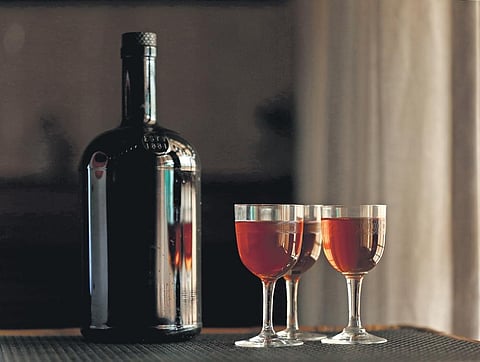

CHENNAI: From the ancient vineyards of Mesopotamia to the bustling wineries of the 21st century, the journey of wine is indeed a captivating one. Around 6000 BCE, the Sumerians began cultivating vineyards, stumbling upon the alchemical process of turning grape juice into wine.
The resulting beverage, though starkly different from modern wines, marked the inception of a tradition that would persist through the ages. As trade routes expanded, so did the knowledge of winemaking. The Egyptians, recognising the potential of fermented grapes, elevated wine to a symbol of luxury and religious significance. Meanwhile, the Greeks, true aficionados, took winemaking to new heights. Dionysus, the God of wine, became a central figure in Greek mythology, emphasising the divine connection between humans and their beloved beverage.
With the expansion of the Roman Empire, wine became a ubiquitous part of daily life. Romans improved upon Greek techniques, introducing innovations such as wooden barrels for ageing and refining grape varieties. Vineyards sprawled across Europe as Roman legions carried the art of winemaking to the farthest corners of their realm.
The fall of the Roman Empire brought a decline in winemaking, but it never disappeared entirely. Monasteries played a crucial role in preserving viticulture knowledge during the Middle Ages. Monks meticulously tended to vineyards, experimenting with blends and perfecting winemaking techniques. Subsequently, wine regained its status as a holy elixir, used in religious ceremonies and shared among the pious.
The Renaissance marked a cultural rebirth in Europe, and wine experienced a renaissance of its own. The French, in particular, elevated winemaking to an art form. The concept of terroir gained prominence, emphasising the unique combination of soil, climate, and grape variety that gives the wine its distinct flavour. Bordeaux and Burgundy emerged as iconic regions, showcasing the intricate nuances of wine production.
As European explorers set sail to discover new lands, they carried vines with them, introducing grape cultivation to the Americas, Africa, and Australia. The exchange of vine varieties between the Old and New Worlds enriched the global tapestry of wine. The Napa Valley in California and the wine regions of South America thus emerged as formidable players on the international stage.
The 19th century saw significant advancements in winemaking technology. The invention of the glass bottle and the introduction of corks revolutionised storage, allowing wines to age gracefully. Railroads and, later, refrigeration facilitated the transportation of wine across vast distances, connecting
producers with consumers on a global scale.
Vine’s tryst in India
India’s wine history is rich but less known. Ancient texts mention ‘Sura’, a form of wine, but it wasn’t as common as other traditional drinks like soma or arrack. Wine’s presence in India dates back to the Indus Valley Civilization and grew through interactions with Persian and European cultures. Reportedly, Emperor Akbar had a dedicated wine-taster, ensuring the quality and safety of his wine, a practice common among royalty to avoid poisoning. Colonial rule in the 19th century marked the early days of Indian viticulture. Nashik, called the ‘Napa Valley of India’, has emerged as a wine hub.
Surprisingly, India’s tropical climate, traditionally considered unsuitable for grape cultivation, has been turned into an advantage, allowing for two harvests a year in some regions — a rarity in the global wine industry. Today, Indian wineries are experimenting with various grape varieties and winemaking techniques, the product starting to find a place in global wine competitions and on international wine lists.
Christmas traditions
The history behind wine in the Christmas celebration originated when Jesus attended a wedding in Cana. “A concerned Mother Mary said there was no wine to serve the guests. Jesus performed a miracle and turned water into wine,” says Oscar C Nigli former MLA and national vice president All-India Anglo-Indian Association. As Christmas is celebrated during the winter season, it is through wine that people share good health, warmth, and happiness. He claims, “Wine is not alcoholic and has health benefits such as aiding to stomach issues. The celebration of Christmas itself is to spread warmth, which brings happiness.”
Keeping this tradition alive, families make wine at home, probably a month before the celebration. “Apart from the grape wine, mulled wine is also prepared which includes spices such as cinnamon, aniseed, cloves, and resins as ingredients,” he shares, adding that the wine takes 40 days to ferment.
(Inputs by Sonu M Kothari)
Food and wine pairing
Sparkling wine and appetisers: Light salty dishes balance the acidity of sparkling wines. Potato chips, fried mushrooms, sausages, and roasted tomato Bruschetta.
Red wine and red meat: If the meat has leaner cuts, pour some light or medium-body wines. Whereas, fatty meats work well with bold red wines. Lamb, beef, veal, pork, and fillet are some chef’s kiss combo with red wine.
Sweet wine and desserts: The sweetness of the wine can be balanced well with desserts like Note, here the wine should be sweeter than the dessert. Chocolate and caramel desserts, cheesecake, tiramisu, and apple pie.
White wine and seafood: Snapper, clams, and oysters are some refreshing contrasts.
Homemade wine by Rachel Nigli, deputy manager, msc India
Ingredients
Grapes: 1 kg
Sugar: 1.5 kg
Water: 1.5 litres
Wheat: 1 tbsp
Egg white: 1
Dry yeast: 1 tsp
This recipe is for 1 kg of wine. Multiply the quantity of ingredients for every extra kilo
METHOD
Note
When refrigerating, do not close the bottle tightly because it will burst due to the fermentation process. If you prefer a darker colour, caramelise a little sugar and add while setting the wine in the initial stage.